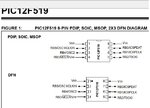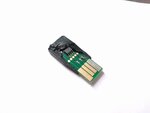saeedazari
Newbie level 5
Hi everyone,
I have a PIC12F519 uc based board which works as something like usb device.
It communicates with the main board with 2 ports (RB0/ICSPDAT & RB1/ICSPCLK) and i have watched its' protocol via saleae logic analyzer.
The protocol seems to be I2C but after looking at data it does not have a meaningful protocol.
I checked it as uart protocol and it did not mean anything either.
Here is some pic of the Saleae logic program:
http://cdn1.imggmi.com/uploads/2018/7/15/3d619702cd0fa3654498bad377009b29-full.jpg
http://cdn1.imggmi.com/uploads/2018/7/15/51a0c1e7c48c6b92e540a3b461bdf337-full.jpg
http://cdn1.imggmi.com/uploads/2018/7/15/20f213f784686adc1360d18c670e6a82-full.jpg
http://cdn1.imggmi.com/uploads/2018/7/15/1e8d683e9a79f4476ddeb166375a0843-full.jpg
Can anyone suggest which protocol is being used between the boards?
I have a PIC12F519 uc based board which works as something like usb device.
It communicates with the main board with 2 ports (RB0/ICSPDAT & RB1/ICSPCLK) and i have watched its' protocol via saleae logic analyzer.
The protocol seems to be I2C but after looking at data it does not have a meaningful protocol.
I checked it as uart protocol and it did not mean anything either.
Here is some pic of the Saleae logic program:
http://cdn1.imggmi.com/uploads/2018/7/15/3d619702cd0fa3654498bad377009b29-full.jpg
http://cdn1.imggmi.com/uploads/2018/7/15/51a0c1e7c48c6b92e540a3b461bdf337-full.jpg
http://cdn1.imggmi.com/uploads/2018/7/15/20f213f784686adc1360d18c670e6a82-full.jpg
http://cdn1.imggmi.com/uploads/2018/7/15/1e8d683e9a79f4476ddeb166375a0843-full.jpg
Can anyone suggest which protocol is being used between the boards?





